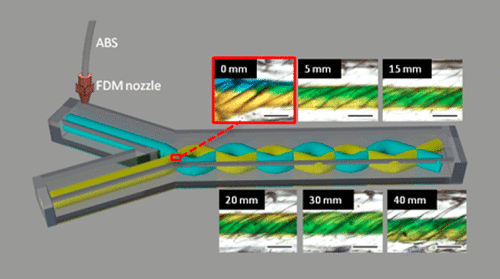当前位置:
X-MOL 学术
›
Anal. Chem.
›
论文详情
Our official English website, www.x-mol.net, welcomes your
feedback! (Note: you will need to create a separate account there.)
Using Printing Orientation for Tuning Fluidic Behavior in Microfluidic Chips Made by Fused Deposition Modeling 3D Printing
Analytical Chemistry ( IF 6.7 ) Pub Date : 2017-11-17 00:00:00 , DOI: 10.1021/acs.analchem.7b03228 Feng Li , Niall P. Macdonald , Rosanne M. Guijt 1 , Michael C. Breadmore
Analytical Chemistry ( IF 6.7 ) Pub Date : 2017-11-17 00:00:00 , DOI: 10.1021/acs.analchem.7b03228 Feng Li , Niall P. Macdonald , Rosanne M. Guijt 1 , Michael C. Breadmore
Affiliation

|
Fluidic behavior in microfluidic devices is dictated by low Reynolds numbers, complicating mixing. Here, the effect of the orientation of the extruded filament on the fluidic behavior is investigated in fused deposition modeling (FDM) printed fluidic devices. Devices were printed with filament orientations at 0°, 30°, 60°, and 90° to the direction of the flow. The extent of mixing was observed when pumping yellow and blue solutions into the inlets of a Y-shaped device, and measuring the extent of mixing of two colored solutions under different angles and at flow rates of 25, 50, and 100 μL/min. Fluidic devices printed with filament extruded at 60° to the flow showed the highest mixing efficiency, but results obtained at 30° suggested more complex fluid movement, as the measured degree of mixing decreased along the fluidic channel at higher flow rates. To explore this, a device with −37° filament orientation on the top surface was designed to align with the direction of the first fluid input channel and +37° on the bottom surface of the channel to align with the direction of the second fluidic input. Results indicated a rotational movement of the fluids down the microchannel, which were confirmed by computational fluid dynamics. These results demonstrate the impact of the filament extrusion direction on fluidic behavior in microfluidic devices made by FDM printing. Two chips with laminar flow (0° filament direction) or mixing flow (+37/−37° filament direction) were used to perform isotachophoresis and colorimetric detection of iron in river water, respectively, demonstrating the simplicity with which the same device can be tuned for different applications simply by controlling the way the device is printed.
中文翻译:

使用打印方向调整通过熔融沉积建模3D打印制成的微流控芯片中的流体行为
低雷诺数决定了微流体装置中的流体行为,使混合变得复杂。在此,在熔融沉积建模(FDM)打印的流体装置中研究了挤出长丝取向对流体行为的影响。器件以与流动方向成0°,30°,60°和90°的灯丝方向进行打印。当将黄色和蓝色溶液泵入Y形设备的入口,并以25、50和100μL/ min的流量在不同角度下测量两种有色溶液的混合程度时,观察到混合程度。印刷有细丝的流体装置以60°的角度挤出到流中,显示出最高的混合效率,但是在30°时获得的结果表明流体运动更为复杂,因为在较高的流速下,沿流体通道测得的混合度降低了。为了探究这一点,设计了一种在顶表面上具有-37°灯丝方向的设备,使其与第一流体输入通道的方向对齐,而在该通道的底表面上具有+ 37°的设备,以与第二流体输入通道的方向对齐。 。结果表明流体沿微通道向下旋转,这已通过计算流体动力学得到证实。这些结果证明了细丝挤出方向对通过FDM印刷制成的微流体装置中的流体行为的影响。分别使用层流(0°细丝方向)或混合流(+ 37 / -37°细丝方向)的两个切屑分别进行等速电泳和比色检测河水中的铁,
更新日期:2017-11-19
中文翻译:

使用打印方向调整通过熔融沉积建模3D打印制成的微流控芯片中的流体行为
低雷诺数决定了微流体装置中的流体行为,使混合变得复杂。在此,在熔融沉积建模(FDM)打印的流体装置中研究了挤出长丝取向对流体行为的影响。器件以与流动方向成0°,30°,60°和90°的灯丝方向进行打印。当将黄色和蓝色溶液泵入Y形设备的入口,并以25、50和100μL/ min的流量在不同角度下测量两种有色溶液的混合程度时,观察到混合程度。印刷有细丝的流体装置以60°的角度挤出到流中,显示出最高的混合效率,但是在30°时获得的结果表明流体运动更为复杂,因为在较高的流速下,沿流体通道测得的混合度降低了。为了探究这一点,设计了一种在顶表面上具有-37°灯丝方向的设备,使其与第一流体输入通道的方向对齐,而在该通道的底表面上具有+ 37°的设备,以与第二流体输入通道的方向对齐。 。结果表明流体沿微通道向下旋转,这已通过计算流体动力学得到证实。这些结果证明了细丝挤出方向对通过FDM印刷制成的微流体装置中的流体行为的影响。分别使用层流(0°细丝方向)或混合流(+ 37 / -37°细丝方向)的两个切屑分别进行等速电泳和比色检测河水中的铁,











































 京公网安备 11010802027423号
京公网安备 11010802027423号